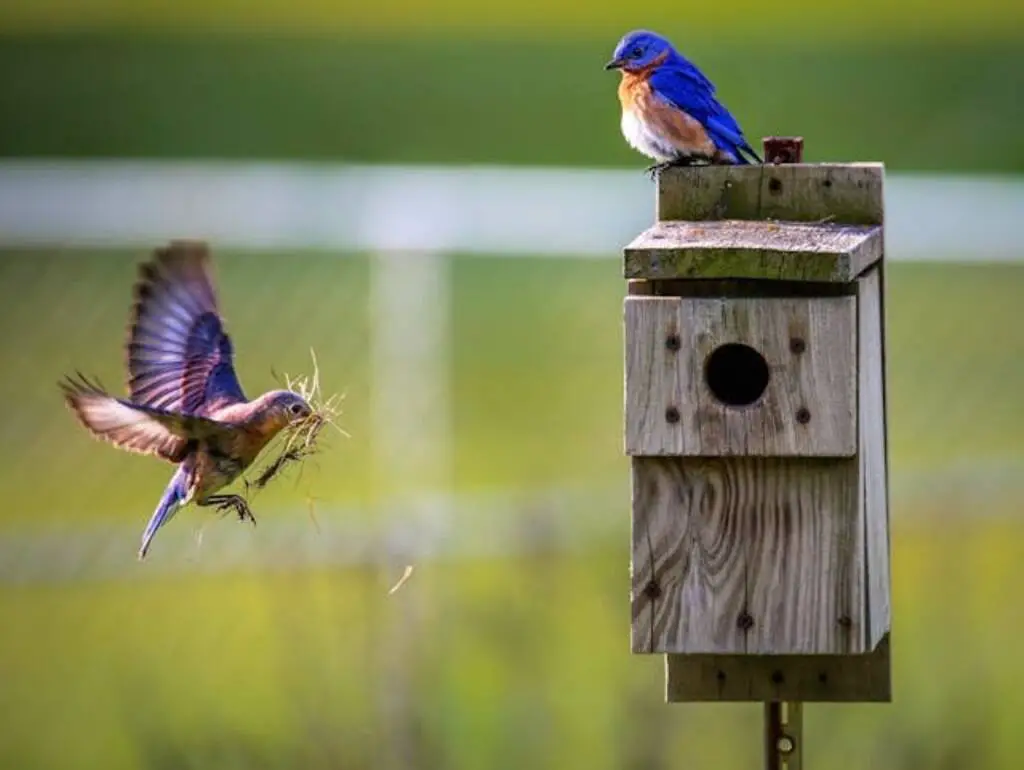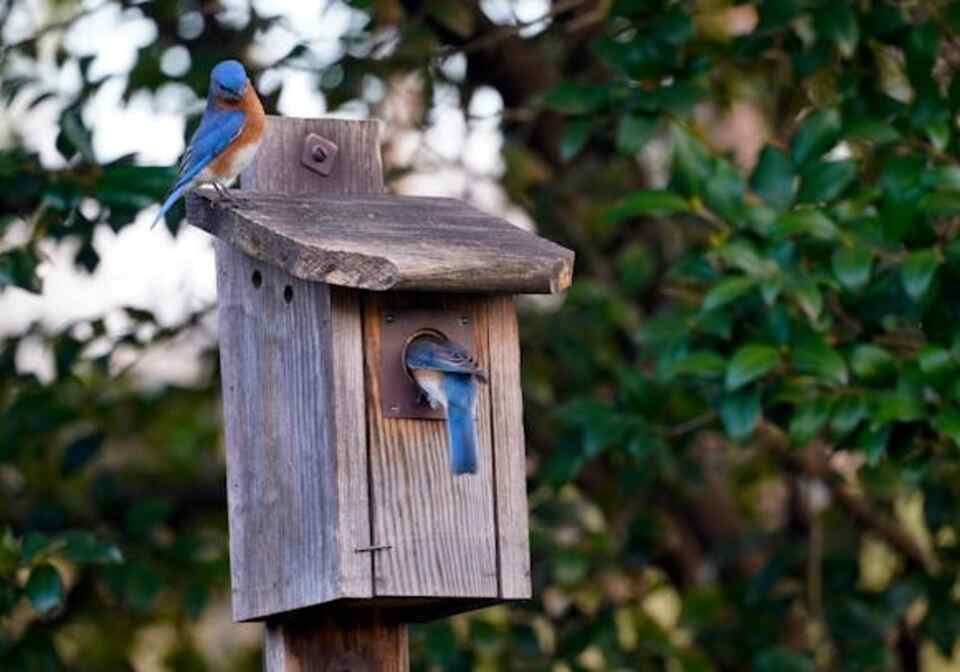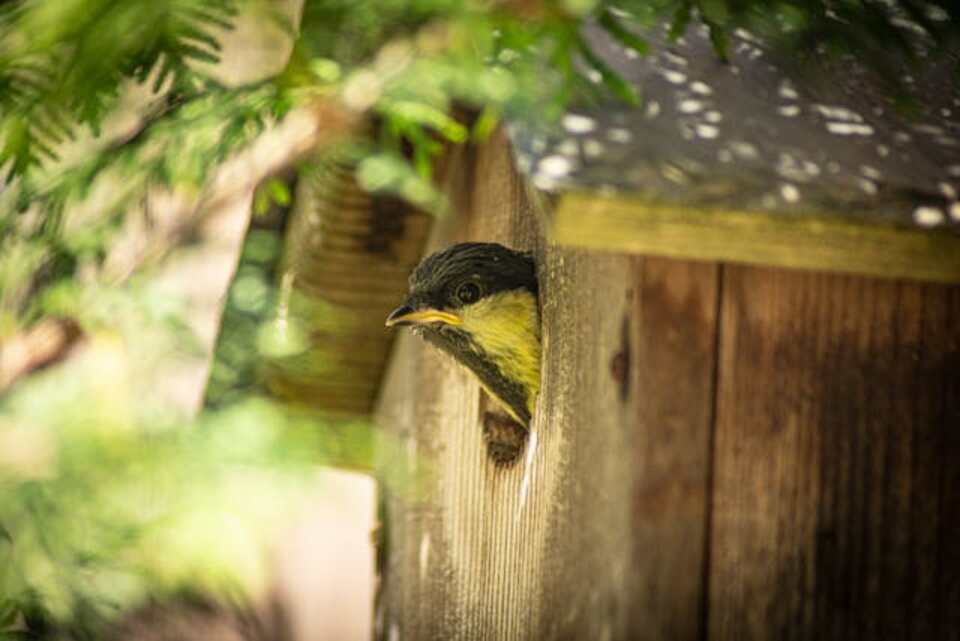Ever wondered what mistakes can ruin your birdhouse setup? Placing it too low, using the wrong materials, or skipping predator protection are just a few things that can drive birds away. A poor setup not only makes birds feel unsafe but can also attract unwanted pests.
In this article, you’ll learn what not to do during your birdhouse setup and how to create a safe, inviting space for nesting birds.
Table of Contents
- 1 The Importance of Birdhouses
- 2 Understanding Birdhouse Basics
- 3 Birdhouse Setup Mistakes to Avoid
- 3.1 1. Neglecting Proper Dimensions
- 3.2 2. Improper Birdhouse Placement
- 3.3 3. Failing to Maintain and Clean the Birdhouse
- 3.4 4. Neglecting Appropriate Ventilation and Drainage
- 3.5 5. Failing to Protect Against Predators
- 3.6 6. Ignoring the Needs of the Target Bird Species
- 3.7 7. Disregarding Local Regulations and Permit Requirements
- 4 Conclusion
- 5 Author
The Importance of Birdhouses
Birdhouses play a vital role in supporting local bird populations, especially in areas where natural nesting cavities are scarce. By providing artificial nesting sites, you can help compensate for the loss of suitable habitats due to urbanization, deforestation, and other human-driven changes to the landscape.
Beyond their practical benefits, birdhouses also offer an opportunity for humans to connect with nature and observe the fascinating behaviors of birds up close. Watching the activity around a well-placed birdhouse can be a source of endless wonder and delight, as you witness the drama of courtship, nest-building, and the joyful sounds of newly hatched chicks.
However, for a birdhouse to be truly successful, it must be carefully designed, positioned, and maintained to meet the specific needs of the target bird species. Failing to do so can lead to a host of problems, from nest failures and reduced breeding success to the unintentional attraction of unwanted or even invasive species.
Understanding Birdhouse Basics
Before diving into the don’ts, it’s essential to have a solid foundation in the basics of birdhouse design and placement. Proper birdhouse setup is crucial for attracting the right bird species and providing them with a secure and comfortable nesting environment.
Birdhouse Dimensions
The size and shape of a birdhouse are critical factors that determine which birds will be attracted to it. Each species has specific preferences when it comes to the internal volume, entrance hole size, and overall dimensions of their ideal nesting cavity.
Failing to adhere to these species-specific guidelines can lead to several problems, such as:
- Unsuitable occupants: Larger bird species may take over a birdhouse intended for smaller birds, leading to competition and potential conflicts.
- Nestling injuries: Entrance holes that are too large can allow predators to reach in and harm the young birds.
- Overcrowding: Birdhouses that are too small may result in cramped conditions, increasing the risk of disease and nestling mortality.
To ensure you’re providing the right-sized birdhouse, research the preferred dimensions for the species you hope to attract. For example, bluebirds require a relatively small, enclosed nesting space, while woodpeckers need a larger cavity. Striking the right balance between the birdhouse’s internal volume and entrance hole size is crucial for creating a safe and comfortable home for your feathered friends.
Birdhouse Orientation and Placement
The location and direction a birdhouse faces can significantly impact its appeal and suitability for different bird species. Factors such as sun exposure, wind protection, and proximity to food and water sources all play a role in the birdhouse’s attractiveness.
Improper placement can deter birds from using the birdhouse or expose the occupants to unnecessary risks, such as:
- Excessive heat or cold: Birdhouses placed in direct sunlight or without adequate shelter can subject the nestlings to temperature extremes.
- Predator accessibility: Positioning a birdhouse too low or in an exposed location makes it vulnerable to predation by cats, raccoons, snakes, and other wildlife.
- Lack of food and water: Birdhouses located too far from natural food sources and water supplies may be less appealing to prospective tenants.
Careful consideration of the birdhouse’s placement and orientation is essential to creating a safe and inviting nesting environment for your feathered friends.
Birdhouse Setup Mistakes to Avoid
Now that we’ve established the importance of understanding birdhouse basics, let’s dive into the specific behaviors and actions you should avoid when setting up a birdhouse in your outdoor space.
1. Neglecting Proper Dimensions
As mentioned earlier, birdhouse dimensions are crucial for attracting the right species and providing them with a suitable nesting environment. Failing to adhere to the recommended size and shape guidelines can have severe consequences for the birds.
- Don’t use a one-size-fits-all approach: Different bird species require different birdhouse dimensions. Ensure you select a model or design that caters to the specific birds you hope to attract. For example, bluebirds prefer a smaller, more confined nesting space, while woodpeckers require a larger cavity.
- Avoid making the birdhouse too large or too small: Oversized birdhouses may attract unwanted occupants, such as invasive species like House Sparrows or European Starlings, which can outcompete native birds. Conversely, undersized birdhouses can lead to overcrowding and nestling injuries, as the young birds may not have enough room to grow and thrive.
- Pay attention to the entrance hole diameter: The hole size should be just large enough for the target species to enter comfortably, but not so big that it invites predators. Smaller birds like chickadees and wrens require a hole diameter of around 1 to 1.1 inches, while larger species like bluebirds and tree swallows need a hole size of 1.5 inches. Try this entrance hole size calculator.
Disregarding the proper birdhouse dimensions can have dire consequences for the birds, potentially leading to nest failures, decreased breeding success, and even the loss of entire broods. By selecting the right-sized birdhouse for your target species, you can ensure a safe and nurturing environment for your feathered friends.
2. Improper Birdhouse Placement
The location and orientation of a birdhouse can make or break its occupancy. Placing it in the wrong spot can expose the birds to various threats and make the birdhouse less appealing.
- Don’t hang birdhouses in direct sunlight: Excessive heat can be detrimental to the nestlings, leading to dehydration and even mortality. Aim to position the birdhouse in a shaded or partially shaded area, preferably with some natural vegetation to provide additional shelter.
- Avoid areas with too much wind and exposure: Birdhouses should be sheltered from strong winds and precipitation to protect the occupants. Look for locations that are out of the path of prevailing winds and away from areas prone to heavy rainfall or snowfall.
- Don’t place birdhouses too close to bird feeders: This can attract unwanted competition and aggressive behavior from other birds, which can disrupt the nesting process and put the young birds at risk.
- Steer clear of busy areas with high human activity: Birdhouses should be positioned away from heavily trafficked zones, such as near playgrounds, patios, or frequently used garden paths, to minimize disturbance and stress to the nesting birds.
- Don’t hang birdhouses too low to the ground: This makes them vulnerable to predators and vandalism. Ideally, birdhouses should be placed at a height of 5 to 15 feet above the ground, depending on the target species.
Additionally, it’s important to consider the proximity of the birdhouse to potential food and water sources. Placing the birdhouse too far from these vital resources can make it less appealing to birds, as they’ll have to expend more energy traveling back and forth to meet their basic needs. Ideally, the birdhouse should be located within 100 feet of a reliable water source, such as a birdbath, pond, or stream, and near natural food sources like berry-producing shrubs or insect-rich vegetation.
3. Failing to Maintain and Clean the Birdhouse
Proper maintenance and cleaning of a birdhouse are essential for ensuring the health and safety of its occupants. Neglecting these tasks can lead to a buildup of parasites, disease, and nesting material that can harm the birds.
- Don’t forget to clean the birdhouse regularly: Remove old nesting material and thoroughly clean the interior between breeding seasons to prevent the spread of diseases and parasites. This is especially important in areas where the birdhouse may have been used by the same birds for multiple years, as the accumulated nesting material can harbor harmful organisms.
- Avoid using harsh chemicals or detergents: These can be toxic to birds and disrupt the natural scents that help birds recognize their nesting sites. Instead, opt for mild soap solutions or a vinegar-and-water mixture to clean the birdhouse.
- Don’t leave old nesting material in the birdhouse: This can attract unwanted pests, such as mites and blowflies, which can infest the nest and harm the young birds. Additionally, old nesting material can harbor harmful bacteria and fungal growth, putting the birds at risk of respiratory issues and other health problems.
- Steer clear of modifying the birdhouse during the breeding season: Avoid any significant changes to the birdhouse while birds are actively nesting, as this can cause them to abandon the nest. Wait until the end of the breeding season to make any necessary repairs or alterations.
Neglecting these maintenance tasks can lead to a buildup of parasites, such as mites and blowflies, which can infest the nest and harm the young birds. Additionally, old nesting material can harbor harmful bacteria and fungal growth, putting the birds at risk of respiratory issues and other health problems.
It’s recommended to clean the birdhouse at the end of each breeding season, typically in late fall or early winter when the birds have vacated the nest. Use a mild soap or vinegar solution to scrub the interior, and avoid using harsh chemicals that could be toxic to the birds. After cleaning, leave the birdhouse open to dry completely before storing it or putting it back up for the next breeding season.
4. Neglecting Appropriate Ventilation and Drainage
Birdhouses need to be designed with proper ventilation and drainage to maintain a healthy and comfortable living environment for the birds.
- Don’t block the ventilation holes: Adequate airflow is crucial for regulating temperature and preventing the buildup of harmful gases, such as ammonia from the birds’ waste. Proper ventilation not only helps to keep the nest cool in hot weather but also allows for the exchange of fresh air, reducing the risk of respiratory issues for the nestlings.
- Avoid birdhouses without drainage holes: Standing water can lead to the growth of mold and bacteria, putting the birds at risk of disease. Ensuring that the birdhouse has properly placed drainage holes, typically located near the floor, can help maintain a dry and sanitary environment for the nesting birds.
- Don’t use materials that can trap moisture: Choose weather-resistant, breathable materials for the birdhouse construction, such as untreated wood or recycled plastic, to prevent the buildup of condensation and maintain a dry interior.
Proper ventilation and drainage are essential for creating a healthy and comfortable nesting environment for the birds. Neglecting these features can lead to a range of problems, from respiratory issues to the growth of harmful microorganisms, ultimately jeopardizing the well-being of the occupants.
5. Failing to Protect Against Predators
Predators pose a significant threat to nesting birds, and it’s crucial to take proactive measures to safeguard the birdhouse and its occupants.
- Don’t hang birdhouses too close to the ground: This makes them easily accessible to predators like cats, raccoons, and snakes. Aim to position the birdhouse at least 5 feet off the ground, and consider using predator guards or baffles to deter potential threats.
- Avoid placing birdhouses near dense vegetation: While birds prefer some cover, excessive foliage can provide hiding spots for predators, making it easier for them to access the nest. Opt for locations with a clear line of sight around the birdhouse.
- Don’t neglect predator guards: Consider installing features like cone baffles, metal predator guards, or predator-resistant entrance holes to make it more difficult for predators to reach the nest.
- Steer clear of using perches on the birdhouse: These can make it easier for predators to access the nest, as they provide a convenient landing spot for unwanted visitors.
Protecting the birdhouse from predators is essential for the survival and success of the nesting birds. By taking proactive measures to deter potential threats, you can significantly increase the chances of a successful breeding season and ensure the safety of the young birds.
6. Ignoring the Needs of the Target Bird Species
Each bird species has unique preferences and requirements when it comes to their nesting habitat. Failing to cater to these specific needs can deter birds from using the birdhouse or lead to unsuccessful breeding attempts.
- Don’t assume a one-size-fits-all approach: Research the nesting habits and preferences of the birds you hope to attract, and tailor the birdhouse accordingly. For example, some species may prefer a more enclosed nesting space, while others thrive in more open-style birdhouses.
- Avoid using the wrong type of nesting material: Different species may prefer specific materials for lining their nests, such as soft grasses, feathers, or even human-provided materials like cotton or wool. Providing the appropriate nesting material can make the birdhouse more inviting and comfortable for the birds.
- Don’t neglect the seasonal needs of the birds: Some species require different birdhouse features or placements during the breeding season versus the winter. For instance, some birds may prefer a more sheltered nesting site in the colder months to protect their young from the elements.
By understanding and catering to the specific needs of your target bird species, you can create a birdhouse that is not only attractive but also provides the necessary conditions for successful breeding and nesting.
7. Disregarding Local Regulations and Permit Requirements
In some areas, there may be specific regulations or permit requirements for installing birdhouses on private or public property. Ignoring these rules can lead to fines, removal of the birdhouse, or even legal consequences.
- Don’t assume you can place a birdhouse anywhere: Research and comply with any local laws or guidelines regarding the installation of birdhouses. Some communities may have restrictions on the type, size, or placement of birdhouses, especially in sensitive natural areas or protected habitats.
- Avoid installing birdhouses in protected or restricted areas: Certain habitats or locations may be off-limits for birdhouse placement without the proper permits or authorizations. Consult with local wildlife authorities or conservation organizations to ensure you’re not interfering with protected species or habitats.
- Don’t neglect to obtain necessary permissions: If you’re planning to install a birdhouse on public land or in a shared community space, be sure to obtain the necessary approvals from the relevant authorities, such as local government agencies or homeowners’ associations. Failure to do so could result in the removal of the birdhouse and potential penalties.
Respecting local regulations and obtaining the appropriate permits, if required, is essential for responsible birdhouse installation and ensuring the long-term success of your efforts to support local bird populations.
Conclusion
Providing a safe and suitable nesting environment for birds in your backyard or garden is a rewarding endeavor that can have a positive impact on local biodiversity. By understanding and avoiding the common mistakes and pitfalls outlined in this comprehensive guide, you can increase the chances of attracting and successfully hosting your feathered friends.
Remember, each bird species has unique needs and preferences, so it’s essential to research and cater to the specific requirements of the birds you hope to attract. With a little planning, diligence, and a commitment to responsible birdhouse setup, you can create a welcoming sanctuary that will bring joy, beauty, and ecological benefits to your outdoor space.
So, avoid the common missteps, follow best practices, and enjoy the wonder of watching birds thrive in the birdhouses you’ve so thoughtfully provided. Your dedication to creating a bird-friendly environment will not only benefit the local avian population but also enrich your own connection to the natural world.
By taking the time to understand the dos and don’ts of birdhouse setup, you’re making a meaningful contribution to the conservation of birds and the preservation of healthy, vibrant ecosystems. The birds will thank you, and the joy and wonder they bring to your backyard or garden will be a gift that keeps on giving, season after season.





